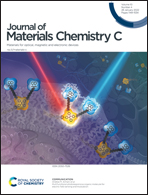Direct conversion X-ray detectors with 70 pA cm−2 dark currents coated from an alcohol-based perovskite ink†
Abstract
Direct conversion X-ray image detectors offer higher spatial resolution than their indirect counterparts. Organic–inorganic hybrid perovskites are among the most sensitive X-ray photoconductors for these detectors; however, high dark currents make it difficult for perovskites to compete with commercial amorphous selenium (a-Se) technology. Here we report a simple perovskite ink formulation that uses environmentally friendly 85% ethanol as the solvent. The ink was used to blade-coat thick perovskite films, which when combined with poly(methyl methacrylate) (PMMA) blocking layers, produce direct conversion detectors with dark currents ∼70 pA cm−2. These dark currents are two to three orders of magnitude lower than those of other perovskite-based detectors and are comparable to those of commercial a-Se devices. Other device figures-of-merit, including X-ray sensitivity and mobility-lifetime (μτ) product, are superior to those of commercial a-Se detectors. Our results demonstrate how to effectively suppress the dark current in perovskite photoconductive X-ray detectors, paving the way for low-dose mammography and radiography.



 Please wait while we load your content...
Please wait while we load your content...